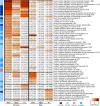GWAS of allometric body-shape indices in UK Biobank identifies loci suggesting associations with morphogenesis, organogenesis, adrenal cell renewal and cancer
- PMID: 34021172
- PMCID: PMC8139988
- DOI: 10.1038/s41598-021-89176-6
GWAS of allometric body-shape indices in UK Biobank identifies loci suggesting associations with morphogenesis, organogenesis, adrenal cell renewal and cancer
Abstract
Genetic studies have examined body-shape measures adjusted for body mass index (BMI), while allometric indices are additionally adjusted for height. We performed the first genome-wide association study of A Body Shape Index (ABSI), Hip Index (HI) and the new Waist-to-Hip Index and compared these with traditional indices, using data from the UK Biobank Resource for 219,872 women and 186,825 men with white British ancestry and Bayesian linear mixed-models (BOLT-LMM). One to two thirds of the loci identified for allometric body-shape indices were novel. Most prominent was rs72959041 variant in RSPO3 gene, expressed in visceral adipose tissue and regulating adrenal cell renewal. Highly ranked were genes related to morphogenesis and organogenesis, previously additionally linked to cancer development and progression. Genetic associations were fewer in men compared to women. Prominent region-specific associations showed variants in loci VEGFA and HMGA1 for ABSI and KLF14 for HI in women, and C5orf67 and HOXC4/5 for ABSI and RSPO3, VEGFA and SLC30A10 for HI in men. Although more variants were associated with waist and hip circumference adjusted for BMI compared to ABSI and HI, associations with height had previously been reported for many of the additional variants, illustrating the importance of adjusting correctly for height.
Conflict of interest statement
The authors declare no competing interests.
Figures






Similar articles
-
Association of body-shape phenotypes with imaging measures of body composition in the UK Biobank cohort: relevance to colon cancer risk.BMC Cancer. 2021 Oct 15;21(1):1106. doi: 10.1186/s12885-021-08820-6. BMC Cancer. 2021. PMID: 34654381 Free PMC article.
-
Allometric versus traditional body-shape indices and risk of colorectal cancer: a Mendelian randomization analysis.Int J Obes (Lond). 2024 May;48(5):709-716. doi: 10.1038/s41366-024-01479-6. Epub 2024 Jan 31. Int J Obes (Lond). 2024. PMID: 38297030 Free PMC article.
-
Associations of obesity and body shape with erythrocyte and reticulocyte parameters in the UK Biobank cohort.BMC Endocr Disord. 2023 Aug 2;23(1):161. doi: 10.1186/s12902-023-01423-1. BMC Endocr Disord. 2023. PMID: 37528422 Free PMC article.
-
Untangling Waist Circumference and Hip Circumference from Body Mass Index with a Body Shape Index, Hip Index, and Anthropometric Risk Indicator.Metab Syndr Relat Disord. 2018 May;16(4):160-165. doi: 10.1089/met.2017.0166. Epub 2018 Mar 13. Metab Syndr Relat Disord. 2018. PMID: 29649376 Review.
-
Various Obesity Indices and Arterial Function Evaluated with CAVI - Is Waist Circumference Adequate to Define Metabolic Syndrome?Vasc Health Risk Manag. 2022 Sep 12;18:721-733. doi: 10.2147/VHRM.S378288. eCollection 2022. Vasc Health Risk Manag. 2022. PMID: 36120718 Free PMC article. Review.
Cited by
-
Oxytocin receptor expression patterns in the human brain across development.Neuropsychopharmacology. 2022 Jul;47(8):1550-1560. doi: 10.1038/s41386-022-01305-5. Epub 2022 Mar 28. Neuropsychopharmacology. 2022. PMID: 35347267 Free PMC article.
-
Epigenome-wide association study of incident type 2 diabetes in Black and White participants from the Atherosclerosis Risk in Communities Study.Diabetologia. 2025 Apr;68(4):815-834. doi: 10.1007/s00125-024-06352-9. Epub 2025 Feb 19. Diabetologia. 2025. PMID: 39971753
-
Genome-wide meta-analysis identifies 22 loci for normal tension glaucoma with significant overlap with high tension glaucoma.Nat Commun. 2024 Nov 17;15(1):9959. doi: 10.1038/s41467-024-54301-2. Nat Commun. 2024. PMID: 39551815 Free PMC article.
-
A Body Shape Index (ABSI), hip index, and risk of cancer in the UK Biobank cohort.Cancer Med. 2021 Aug;10(16):5614-5628. doi: 10.1002/cam4.4097. Epub 2021 Jul 1. Cancer Med. 2021. PMID: 34196490 Free PMC article.
-
Fine-scale population structure and widespread conservation of genetic effect sizes between human groups across traits.Nat Genet. 2025 Feb;57(2):379-389. doi: 10.1038/s41588-024-02035-8. Epub 2025 Feb 3. Nat Genet. 2025. PMID: 39901012 Free PMC article.
References
Publication types
MeSH terms
Grants and funding
LinkOut - more resources
Full Text Sources
Other Literature Sources

